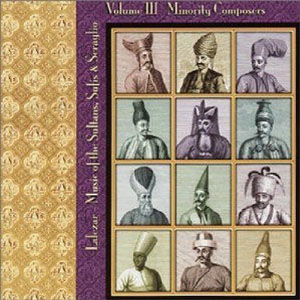Turkey is strategically located at one of the world’s major crossroads. This applies to religion, culture, government and the arts as well as its physical location along trade routes. And for several hundred years ending in the early 20th Century, Turkey was also the center of the Ottoman Empire, which ruled vast territory in Africa, the Middle East and Europe.
Parts of the West are currently in the midst of an upswing of interest in things Turkish, and the set of which these discs are a part capitalizes on that interest by presenting an in-depth look at the music of the Ottoman Empire.
The Lalezar Ensemble comprises four instrumental musicians and three vocalists. These recordings are richly atmospheric, beautifully performed works, redolent of the grandeur, mystery and courtliness of the Empire.
This music sounds like the music of an empire — proud, confident, complex, lyrically and stylistically rich.
 Volume III, Minority Composers, presents the works of Greek, Armenian and Jewish musicians from the late 17th century to early 20th. These peoples represented three of the largest non-Muslim groups in the cities of the Turkish-speaking part of the empire; and though non-Muslim, they were considered an integral part of Ottoman society. Composers from all three of the groups incorporated elements of their religious music into popular, secular Ottoman art music; and all three groups borrowed from each other as well.
Volume III, Minority Composers, presents the works of Greek, Armenian and Jewish musicians from the late 17th century to early 20th. These peoples represented three of the largest non-Muslim groups in the cities of the Turkish-speaking part of the empire; and though non-Muslim, they were considered an integral part of Ottoman society. Composers from all three of the groups incorporated elements of their religious music into popular, secular Ottoman art music; and all three groups borrowed from each other as well.
In the beginning of this period, most of the music was for performance in the royal court or in the halls of the mighty. By the end of the period, nightclubs known as gazinos and the new media of radio and recordings were the focus of these musicians and their art, which now catered to the middle class.
The earlier works, especially those of the Greek composers like Angelos in the first track, closely resembles French court music of the Renaissance with its light percussion on handheld drums and plucked or bowed stringed instruments. Of course, the modes or key signatures are different, obviously Middle Eastern, but the feel is similar.
The Jewish music from the earlier years is especially striking. A good example is the fifth track by the cantor Tanburi Isak, a love song delivered in a strong baritone with lots of semitonal vibrato. Another example of the Jewish music, from the later gazino period by Isak al Gazi, is delivered in a soaring vocal style in Turkish. The CD ends on a beautiful and stately note with a sultry love song delivered by the ensemble’s female vocalist, Selma Sagbas, the title of which translates as “The Dagger of Your Eyebrows.”
 Volume IV, Ottoman Suite, is less accessible and less varied than Minority Composers, but no less beautiful. It consists of a full concert-length suite of Ottoman court music. The pieces range from instrumental improvisations to highly lyrical vocal works, all built around the common thread of a mode (a complex key signature) known as Segah. The works range from 18th century Persian and Sufi songs to early 20th century art songs.
Volume IV, Ottoman Suite, is less accessible and less varied than Minority Composers, but no less beautiful. It consists of a full concert-length suite of Ottoman court music. The pieces range from instrumental improvisations to highly lyrical vocal works, all built around the common thread of a mode (a complex key signature) known as Segah. The works range from 18th century Persian and Sufi songs to early 20th century art songs.
Both of these discs come with a 40-page booklet that explains the music’s history and meaning, and gives brief biographies of the composers and their place in the history of Turkish music. Each also has an overview of Turkish music in general, biographies of the musicians and singers, and introductions to the instruments they use.
The booklets and, to some extent, the CDs themselves seem geared more toward musicians and serious students — much of the information is fairly technical — but that doesn’t detract from the beauty of the music or of these performances. I can assuredly recommend these discs, particularly Vol. III, Minority Composers, to anyone interested in learning more about Turkish music.
(Both Traditional Crossroads, 2001)
